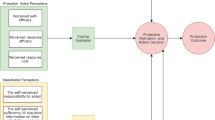Abstract
Self-protective behavior by residents of flood-prone urban areas can reduce monetary flood damage by 80%, and reduce the need for public risk management. But, research on the determinants of private households’ prevention of damage by natural hazards is rare, especially in Germany. To answer the question of why some people take precautionary action while others do not, a socio-psychological model based on Protection Motivation Theory (PMT) is developed, explaining private precautionary damage prevention by residents’ perceptions of previous flood experience, risk of future floods, reliability of public flood protection, the efficacy and costs of self-protective behavior, their perceived ability to perform these actions, and non-protective responses like wishful thinking. The validity of the proposed model is explored by means of representative quantitative telephone surveys and regression analyses, and compared with a socio-economic model (including residents’ age, gender, income, school degree and being owner or tenant). Participants were 157 residents of flood-prone homes in Cologne, Germany, a city that has traditionally been subject to minor and major flood events. Results of the study show the explanatory power of the socio-psychological model, with important implications for public risk communication efforts. To motivate residents in flood-prone areas to take their share in damage prevention, it is essential to communicate not only the risk of flooding and its potential consequences, but also the possibility, effectiveness and cost of private precautionary measures.
Similar content being viewed by others
References
S. C. S. Abraham P. Sheeran D. Abrams R. Spears (1994) ArticleTitleExploring teenagers’ adaptive and maladaptive thinking in relation to the threat of HIV infection Psychol. Health 9 253–272
P. Bell J. Fisher A. Baum T. Greene (1990) Environmental Psychology EditionNumber3 Holt, Rinehart and Winston, Inc. Fort Worth
A. Bryman D. Cramer (1994) Quantitative Data Analysis for Social Scientists Routledge London
T. E. Bunting L. Guelke (1979) ArticleTitleBehavioral and perception geography: a critical appraisal Ann. Assoc. Am. Geogr. 69 IssueID3 448–462
D. R. Eppright J. F. Tanner SuffixJr. Hunt (1994) ArticleTitleKnowledge and the ordered protection motivation model: Tools for preventing AIDS J. Bus. Res. 30 13–24 Occurrence Handle10.1016/0148-2963(94)90064-7
G. Evans S. Cohen (1987) Environmental stress D. Stokols I. Altman (Eds) Handbook of Environmental Psychology John Wiley & Sons New York
Festinger, L.: 1957, A Theory of Cognitive Dissonance. Row, Peterson, Evanston/III
A. Fink U. Ulbrich H. Engel (1996) ArticleTitleAspects of the January 1995 flood in Germany Weather 51 34–39
D. L. Floyd S. Prentice-Dunn R. W. Rogers (2000) ArticleTitleA meta-analysis of research on protection motivation theory J. Appl. Soc. Psychol. 30 407–429
M. F. Flynn R. D. Lyman S. Prentice-Dunn (1995) ArticleTitleProtection motivation theory and adherence to medical treatment regimens for muscular dystrophy J. Soc. Clin. Psychol. 14 61–75
G. Gardner (1978) ArticleTitleEffects of federal human subjects regulations on data obtained in environmental stressor research J. Pers. Soc. Psychol. 36 628–634
International Commission for the Protection of the Rhine: 2002, Non structural flood plain management – measures and their effectiveness. http://www.iksr.org/pdf/RZ_iksr_engl.pdf
Kunreuther, H.: 1978, Even Noah built an ark. The Wharton Magazine (Summer), pp. 28–35
M. K. Lindell R. W. Perry (2000) ArticleTitleHousehold adjustment to earthquake hazard: A review of research Environ. Behav. 32 IssueID4 461–501 Occurrence Handle10.1177/00139160021972621
McCarthy, J. J., Canziani, O. F., Leary, N. A. J., Dokken, D. J. and White, K. S. (Eds.): 2001, Climate Change 2001: Impacts, Adaptation and Vulnerability. Contribution of Working Group II to the Third Assessment Report of the Intergovernmental Panel on Climate Change (IPCC), Cambridge University Press
W. J. McGuire (1985) Attitudes and Attitude Change G. Lindzey E. Aronson (Eds) Handbook of Social Psychology NumberInSeriesVol. II Random House New York 233–346
S. Milne P. Sheeran S. Orbell (2000) ArticleTitlePrediction and Intervention in Health-Related Behavior: A Meta-Analytic Review of Protection Motivation Theory J. Appl. Soc. Psychol. 30 106–143
J.-P. Mulilis R. Lippa (1990) ArticleTitleBehavioral change in earthquake preparedness due to negative threat appeals: a test of protection motivation theory J. Appl. Soc. Psychol. 20 619–638
Munich Re: 2002, Annual Review: Natural Catastrophes 2002. Topics. http://www.munichre.com/ pdf/topics_2002_e.pdf
L. A. Peek D. S. Mileti (2002) The history and future of disaster research R. B. Bechtel A. Churchman (Eds) Handbook of Environmental Psychology John Wiley & Sons New York 511–524
P. A. Rippetoe R. W. Rogers (1987) ArticleTitleEffects of components of protection motivation theory on adaptive and maladaptive coping with a health threat J. Pers. Soc. Psychol. 52 596–604
R. W. Rogers (1983) Cognitive and physiological processes in fear appeals and attitude change: A revised theory of protection motivation B. L. Cacioppo L. L. Petty (Eds) Social Psychophysiology: A Sourcebook Guilford London, UK 153–176
R. W. Rogers S. Prentice-Dunn (1997) Protection motivation theory D. S. Gochman (Eds) Handbook of Health Behavior Research. I: Personal and Social Determinants Plenum New York, NY 113–132
R. Schwarzer (1992) Self-efficacy in the adoption and maintenance of health behaviors: Theoretical approaches and a new model R. Schwarzer (Eds) Self-efficacy: Thought Control of Action Hemisphere Washington, DC 217–243
R. Schwarzer R. Fuchs (1996) Self-efficacy and health behaviors M. Conner P. Norman (Eds) Predicting Health Behavior: Research and Practice with Social Cognition Models Open University Press Buckingham, UK 163–196
J. F. Tanner SuffixJr. E. Day M. R. Crask (1989) ArticleTitleProtection motivation theory: An extension of fear appeals theory in communication J. Bus. Res. 19 267–276
F. W. Velde Particlevan der J. Pligt Particlevan der (1991) ArticleTitleAIDS-related health behavior: Coping, protection motivation, and previous behavior J. Behav. Med. 14 429–451 Occurrence Handle10.1007/BF00845103
N. D. Weinstein (1989) ArticleTitleEffects of personal experience on self-protective behavior Psychol. Bull. 105 31–50 Occurrence Handle10.1037/0033-2909.105.1.31
N. D. Weinstein A. J. Rothman M. Nicolich (1998) ArticleTitleUsing correlations to study relationships between risk perceptions and preventive behavior Psychol. Health 13 479–501
Author information
Authors and Affiliations
Corresponding author
Rights and permissions
About this article
Cite this article
Grothmann, T., Reusswig, F. People at Risk of Flooding: Why Some Residents Take Precautionary Action While Others Do Not. Nat Hazards 38, 101–120 (2006). https://doi.org/10.1007/s11069-005-8604-6
Received:
Accepted:
Issue Date:
DOI: https://doi.org/10.1007/s11069-005-8604-6




